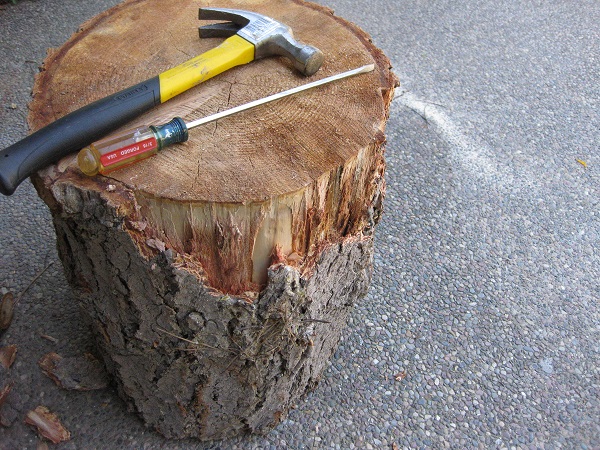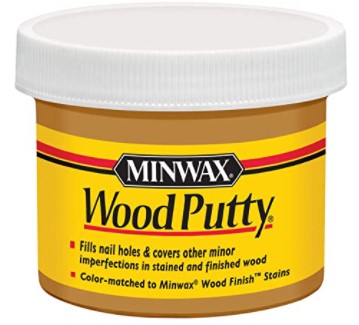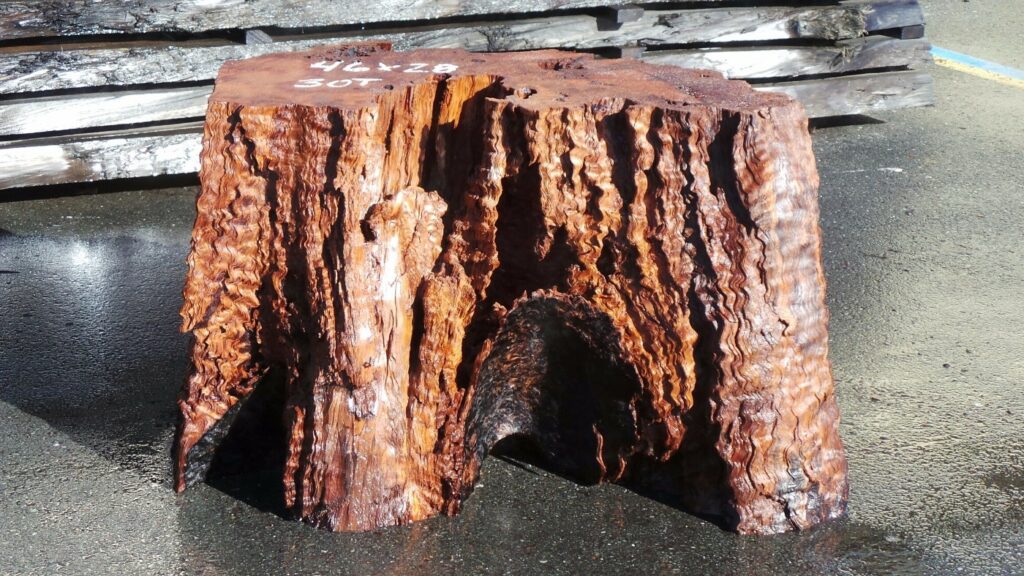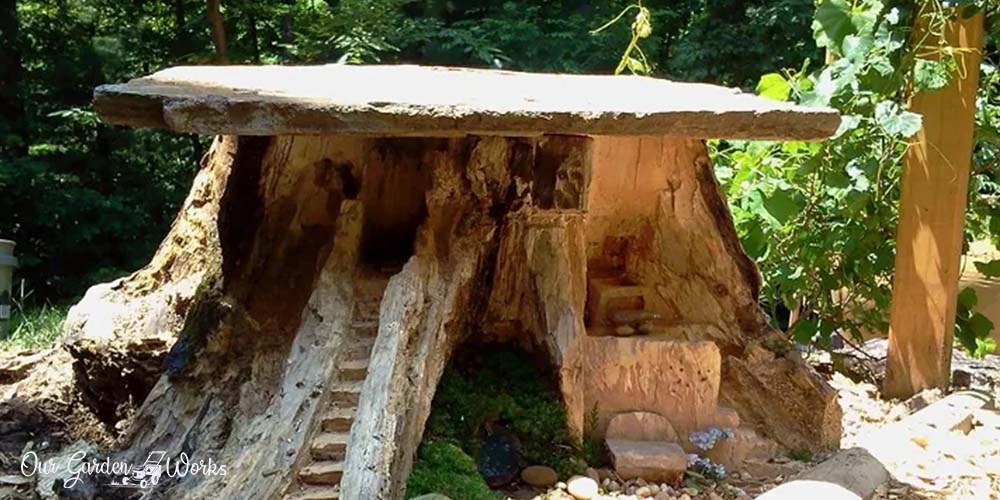A tree has many uses even on its death. A newly cut tree always leaves a tree stump in the ground which can be used for several purposes.
Learning how to preserve a tree stump is an essential step in repurposing the remnants of a fallen tree.
Trees are usually cut when they are starting to die, already dead, or needed for their wood. Tree stumps are small remaining portions of a tree with the roots still buried in the ground.
Instead of leaving them to rot in the ground, gardeners use them for other purposes, such as:
- A planter for new plant species.
- A re-sprouting ground.
- An additional indoor and outdoor furniture for your home.
If you are thinking of ways to reuse the tree stump in your yard, we will help you preserve it and get creative ideas on giving it another purpose.
What To Expect In A Tree Stump
A tree stump is a by-product of trees that are cut for firewood or a leftover of felling.
When you look at a stump, it has rings that indicate its estimated age. Some trees are felled because of their age, while some are intentionally cut for coppicing.
Coppicing is a technique of repeatedly felling trees at the base and allowing them to regrow.
The size of the tree matters when you preserve a tree stump. Large tree stumps can be preserved in the ground and small ones can be removed to serve another purpose.
However, tree stumps should not be left unattended for a long time. They can attract uninvited guests like pests, which can consider your tree stumps as their new home.
Advantages of Preserving A Tree Stump
A tree stump can be leftover to some, but it is a gold mine for the resourceful ones.
Here are some of the advantages of repurposing the tree stumps in your backyard:
1. Prevents Pests From Settling Into Your Property
Since the tree stump will be repurposed, it will not be left on the ground to rot. The decaying roots and lower limb of the tree can attract pests and insects in your backyard and start an infestation.
2. Good Source of Extra Wood/Lumber or Firewood

Depending on the size of the tree, the tree stump can be a good source of wood or lumber for your DIY projects or repurposed into firewood, charcoal, wood chips, and pellets.
3. An Additional Indoor or Outdoor Furniture
If properly preserved, the wood obtained from tree stumps can be used as high-grade furniture, such as a cozy coffee table or a wooden stool.
4. A New Biodegradable Home For Plants
While dead trees are not the most appealing sight in your backyard, deadwood aids in plant growth by providing essential nutrients to the soil as it decomposes.
The fungi, bacteria, and other living forms will speed up the decomposition of the tree stump and make the nutrients readily available for your growing plants.
5 Helpful Steps on How To Preserve a Tree Stump
Preserving a tree stump may seem like an easy task, but it is more than what meets the eye. You have to prepare the stump and let it season in the sun for a while before you fully work your way on its wood.
Here are the 5 steps on how to preserve a stump:
Step #1: Drying
The first step in preserving a tree stump is to make sure that it is fully dry. Leave the newly cut tree stumps on the ground for several months. The minimum drying time is at least a month before you start the cleaning process.
Step #2: Cleaning
Before you can use the tree stump, you have to remove its unusable and unnecessary parts.
Here’s how you can clean a dried tree stump:
(1)Start cleaning the tree stump by removing its bark. A clear sign that you completely removed the bark is when you see the bare interior wood. You can remove the bark by hand, or use some tools, such as a pry bar, chisel, or hammer.

A tell-tale sign that the duration of the drying process is not enough is when it is difficult to remove the bark. If so, you must dry the tree stump for a few more weeks or months.
Pro tip: During the removal process, prevent the tools from damaging the wood to avoid leaving unsightly tool marks or destroying unique wood patterns and bug markings on the stump.
(2)After removing the bark, wipe the tree stump with a clean rag and brush it with a stiff-bristled brush to draw out any remaining dirt or debris.
Dirt buildup in the cracks or around the knots of the stump can be scrubbed or scraped out using a flat-nose screwdriver.
Step #3: Sanding and Filling
Raw wood is too porous to be used for your projects. You have to sand and fill it first so you can achieve a smoother wood finish.
Here’s how:
(1)Start sanding the tree stump particularly from its large surfaces to the sides where the bark was removed. Use a medium to fine-grit sandpaper for sanding the stump. It is recommended to use 80-grit sandpaper for a better finish.
Repeat this process from the top and bottom of the stump by using the rings as your guide while you sand. Continue sanding the wood until there are no longer bumps or rough parts on its surface.
Pro tip: To check your progress, make it a habit to brush the sawdust and grains from time to time.
(2)After the initial sanding, repeat the steps above using sandpaper with a finer grit. This will help you achieve a smoother and more even finish.
This step is optional. If you don’t need the wood to be extra smooth, you can skip this part.
Step #4: Filling The Gaps, Cracks, and Other Wood Imperfections
Wood stabilization is a process wherein resin is injected into the wood to make it more stable or hard. You can do this by applying multiple coats of wood stabilizer. Gradually spread it in a circular motion and make sure that all surfaces are covered.
During the cleaning and sanding process, you may notice some cracks, holes, or breaks in the wood. To preserve the quality of the wood, you need to fill in those wood imperfections.
Here are some tools that you can use to conceal wood imperfections:

- Wood putty is typically made from plastic and used to fill small holes in the wood. Minwax is one of the highly-rated brands of wood putty in the market due to its wood-like finish.
- Wood filler is a popular solution for filling any wood imperfection. It is made with sawdust, solvent, or wood fibers that can blend well with unfinished wood. The best wood fillers for tree stump projects are DAP All-Purpose Plastic Wood Filler and GoodFilla Water-Based Wood Filler.
Pro Tip: Use tape around the area where there is a possible leak and fill it with epoxy. Make sure to let it dry completely before you remove the tape.
Wood stabilization is an important step in preserving wood from tree stumps. It helps improve the woods’ physical properties such as strength, durability, and hardness.
However, there will still be differences in the end product as it will still depend on the condition of the wood and if the process is done properly.
Step #5: Final Touches
Keep the surface of the wood smooth by wiping the stump to remove loose wood grains and excess fillers with clean cotton or microfiber. If you used too much wood filler, rub it off with a ball of steel wool.
Additional wax coats are optional but can be added until your desired finish is achieved. Allow the wax to set for at least one hour or overnight.
If you opt to keep some of the bark, you can apply a sealant spray to protect it from environmental damages, such as dirt, moisture, dust, or the harsh sun. It is best to let it dry overnight.
Tips For Effective Tree Stump Preservation
(1) The characteristics of a tree stump suitable for preservation are durability and resistance to breakage or decay.
Some of the best types of wood for tree stump preservation include:

- Redwood (Sequoia sempervirens)
- Oak (Quercus spp.)
- Western red cedar (Thuja plicata)
(2) If the coarse roots of a stump are still buried on the ground, make sure that the entire tree is fully removed, then saw off the part that you need.
This is to prevent other insects or pests from living in the remaining parts of the dead tree.
(3) Make sure that the tree stump is completely dry before sanding it off. The cells in the wood are basically like a sponge soaking up water and expanding.
It will just ruin your sandpaper and waste your time because you will sand it all over again once the wood is all dried up.
Frequently Asked Questions (FAQs)
How long will a tree stump last?
A stump that is naturally left behind especially by a big tree can last up to a decade (10 years) even without treatment. But a preserved tree stump, like any other treated wood, can last up to forty years or more.
How do you dry out a tree stump?
The simplest and most natural way of drying out a tree stump is to let it stay still in a place free from moisture.
Placing it in an indoor environment is highly recommended for at least a month. But the longer it stays indoors, the better, as it will make it easier to remove the bark once you start the cleaning process.
How do you preserve a tree trunk slice?
Preserving a tree trunk slice is the same as the process of preserving a tree cutting from a stump. If you are going to use it for a later time, simply follow the steps provided above.
Will bleach kill a tree stump?
Yes, but it will depend on the type of tree. There are tree stumps that are easily killed with bleach on the first try, but some need multiple sessions or stronger bleach brands before taking effect.
Do tree stumps attract termites?
Is it really necessary to uproot tree stumps?
Total removal of tree stumps depends on their location and purpose. If the tree is old, dead, and located in the forest, it is better to leave it as it is since its decomposition will help in the forest’s ecosystem. The same goes if the purpose is to re-sprout the stump. Regardless if it is in the forest or your backyard, you do not need to uproot the tree stump.
On the other hand, if it is cut or felled for the reason of tree removal, you must make sure that you will uproot the stump, and whatever comes after is up to you.
Final Thoughts
In life, falling is not the end. Sometimes, it is the start of something new. Like trees, their life does not end after being felled. Even its stumps can be used for other useful things with proper preservation.
We hope that this post was able to help you with the steps on how to preserve your tree stumps.
If you found this post useful, please share it with your friends and colleagues. Also, share your experience with your stump preservation in the comment section below!
What DIY did you work on after preserving your tree stump?

